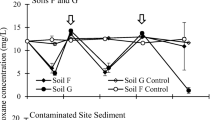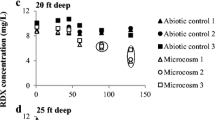Abstract
1,4-Dioxane is a pervasive and persistent contaminant in numerous aquifers. Although the median concentration in most contaminant plumes is in the microgram per liter range, a subset of sites have contamination in the milligram per liter range. Most prior studies that have examined 1,4-dioxane concentrations in the hundreds of milligrams per liter range have been performed with industrial wastewater. The main objective of this study was to evaluate aerobic biodegradation of 1,4-dioxane in microcosms prepared with soil and groundwater from a site where concentrations range from ~ 1500 mg·L−1 in the source zone, to 450 mg·L−1 at a midpoint of the groundwater plume, and to 6 mg·L−1 at a down-gradient location. Treatments included biostimulation with propane, addition of propane and a propanotrophic enrichment culture (ENV487), and unamended. The highest rates of biodegradation for each location in the plume occurred in the bioaugmented treatments, although indigenous propanotrophs also biodegraded 1,4-dioxane to below 25 µg·L−1. Nutrient additions were required to sustain biodegradation of propane and cometabolism of 1,4-dioxane. Among the unamended treatments, biodegradation of 1,4-dioxane was detected in the mid-gradient microcosms. An isolate was obtained that grows on 1,4-dioxane as a sole source of carbon and energy and identified through whole-genome sequencing as Pseudonocardia dioxivorans BERK-1. In a prior study, the same strain was isolated from an aquifer in the southeastern United States. Monod kinetic parameters for BERK-1 are similar to those for strain CB1190.




Similar content being viewed by others
Data availability
All data are available by contacting the corresponding author.
References
Adamson DT, Mahendra S, Walker KL et al (2014) A multisite survey to identify the scale of the 1,4-dioxane problem at contaminated groundwater sites. Environ Sci Technol Lett 1:254–258. https://doi.org/10.1021/ez500092u
Adamson DT, Anderson RH, Mahendra S, Newell CJ (2015) Evidence of 1,4-dioxane attenuation at groundwater sites contaminated with chlorinated solvents and 1,4-dioxane. Environ Sci Technol 49:6510–6518
Adamson DT, Wilson JT, Freedman DL et al (2021) Establishing the prevalence and relative rates of 1,4-dioxane biodegradation in groundwater to improve remedy evaluations. J Hazard Mater. https://doi.org/10.1016/j.jhazmat.2021.127736
Anderson JE, McCarty PL (1997) Transformation yields of chlorinated ethenes by a methanotrophic mixed culture expressing particulate methane monooxygenase. Appl Environ Microbiol 63:687–693
Barajas-Rodriguez FJ, Freedman DL (2018) Aerobic biodegradation kinetics for 1,4-dioxane under metabolic and cometabolic conditions. J Hazard Mater 350:180–188
Barajas-Rodriguez FJ, Murdoch LC, Falta RW, Freedman DL (2019) Simulation of in situ biodegradation of 1,4-dioxane under metabolic and cometabolic conditions. J Contam Hydrol. https://doi.org/10.1016/j.jconhyd.2019.02.006
Braddock JF, Ruth ML, Catterall PH et al (1997) Enhancement and inhibition of microbial activity in hydrocarbon-contaminated arctic soils: implications for nutrient-amended bioremediation. Environ Sci Technol 31:2078–2084
Chen DZ, Jin XJ, Chen J et al (2016) Intermediates and substrate interaction of 1,4-dioxane degradation by the effective metabolizer Xanthobacter flavus DT8. Int Biodeterior Biodegrad 106:133–140. https://doi.org/10.1016/j.ibiod.2015.09.018
Garcia AAR (2020) Evaluation of in situ bioremediation of 1,4-dioxane under aerobic and anaerobic conditions. Clemson University, Clemson
García ÁAR, Adamson DT, Wilson JT et al (2022) Evaluation of natural attenuation of 1,4-dioxane in groundwater using a 14C assay. J Hazard Mater. https://doi.org/10.1016/j.jhazmat.2021.127540
Grady CPL Jr, Daigger GT, Love NG, Filipe CDM (2011) Biological wastewater treatment. CRC Press, Boca Raton
Hareland WA, Crawford RL, Chapman PJ, Dagley S (1975) Metabolic function and properties of 4-hydroxyphenylacetic acid 1-hydroxylase from Pseudomonas acidovorans. J Bacteriol 121:272–285
Hopkins GD, Munakata J, Semprini L, McCarty PL (1993) Trichloroethylene concentration effects on pilot field-scale in-situ groundwater bioremediation by phenol-oxidizing microorganisms. Environ Sci Technol 27:2542–2547
Inoue D, Tsunoda T, Sawada K et al (2016) 1,4-Dioxane degradation potential of members of the genera Pseudonocardia and Rhodococcus. Biodegradation 27:277–286
Interstate Technology Regulatory Council (2021) Technical resources for addressing environmental releases of 1,4-dioxane. https://14d-1.itrcweb.org/. Accessed 20 May 2021
Jackson LE, Lemke LD (2019) Evidence for natural attenuation of 1,4-dioxane in a glacial aquifer system. Hydrogeol J 27:3009–3024. https://doi.org/10.1007/s10040-019-02028-6
Jitnuyanont P, Sayavedra-Soto L, Semprini L (2001) Bioaugmentation of butane-utilizing microorganisms to promote cometabolism of 1,1,1-trichloroethane in groundwater microcosms. Biodegradation 12:11–22. https://doi.org/10.1023/A:1011933731496
Lippincott D, Streger SH, Schaefer CE et al (2015a) Bioaugmentation and propane biosparging for in situ biodegradation of 1,4-dioxane. Groundw Monit Remediat 35:81–92. https://doi.org/10.1111/gwmr.12093
Lippincott D, Streger SH, Schaefer CE et al (2015b) Bioaugmentation and propane biosparging for in situ biodegradation of 1,4-dioxane. Groundw Monit Remediat. https://doi.org/10.1111/gwmr.12093
Mahendra S, Alvarez-Cohen L (2005) Pseudonocardia dioxanivorans sp. nov., a novel actinomycete that grows on 1,4-dioxane. Int J Syst Evol Microbiol 55:593–598
Masuda H, McClay K, Steffan RJ, Zylstra GJ (2012) Biodegradation of tetrahydrofuran and 1,4-dioxane by soluble diiron monooxygenase in Pseudonocardia sp. strain ENV478. J Mol Microbiol Biotechnol 22:312–316
Neter J, Kutner MH, Nachtsheim CJ, Wasserman W (1996) Applied linear statistical models. Irwin, Chicago
Parales RE, Adamus JE, White N, May HD (1994) Degradation of 1,4-dioxane by an actinomycete in pure culture. Appl Environ Microbiol 60:4527–4530
Ramos-Garcia AA, Shankar V, Saski CA et al (2018) Draft genome sequence of the 1,4-dioxane-degrading bacterium Pseudonocardia dioxanivorans BERK-1. Genome Announc 6:e00207–e00218
Reichert P (1994) AQUASIM-A tool for simulation and data analysis of aquatic systems. Water Sci Technol 30:21
Rolston HM, Hyman MR, Semprini L (2019) Aerobic cometabolism of 1,4-dioxane by isobutane-utilizing microorganisms including Rhodococcus rhodochrous strain 21198 in aquifer microcosms: experimental and modeling study. Sci Total Environ 694:133688. https://doi.org/10.1016/j.scitotenv.2019.133688
Sales CM, Mahendra S, Grostern A et al (2011) Genome sequence of the 1,4-dioxane-degrading Pseudonocardia dioxanivoransstrain CB1190. J Bacteriol 193:4549–4550
Sei K, Oyama M, Kakinoki T et al (2013) Isolation and characterization of tetrahydrofuran-degrading bacteria for 1,4-dioxane-containing wastewater treatment by co-metabolic degradation. J Water Environ Technol 11:11–19
Steffan RJ, McClay K, Vainberg S et al (1997) Biodegradation of the gasoline oxygenates methyl tert-butyl ether, ethyl tert-butyl ether, and tert-amyl methyl ether by propane-oxidizing bacteria. Appl Environ Microbiol 63:4216–4222
Tusher TR, Shimizu T, Inoue C, Chien M-F (2020) Enrichment and analysis of stable 1,4-dioxane-degrading microbial consortia consisting of novel dioxane-degraders. Microorganisms 8:50
Verce MF, Freedman DL (2000) Modeling the kinetics of vinyl chloride cometabolism by an ethane-grown Pseudomonas sp. Biotechnol Bioeng 71:274–285
Zenker MJ, Borden RC, Barlaz MA (2002) Modeling cometabolism of cyclic ethers. Environ Eng Sci 19:215–228
Zhang S, Gedalanga PB, Mahendra S (2016) Biodegradation kinetics of 1,4-dioxane in chlorinated solvent mixtures. Environ Sci Technol 50:9599–9607
Funding
This work is supported by Dow.
Author information
Authors and Affiliations
Corresponding author
Ethics declarations
Conflict of interest
The authors state that there are no conflict of interest in this work.
Additional information
Publisher's Note
Springer Nature remains neutral with regard to jurisdictional claims in published maps and institutional affiliations.
Supplementary Information
Below is the link to the electronic supplementary material.
Rights and permissions
About this article
Cite this article
Ramos-García, Á.A., Walecka-Hutchison, C. & Freedman, D.L. Effect of biostimulation and bioaugmentation on biodegradation of high concentrations of 1,4-dioxane. Biodegradation 33, 157–168 (2022). https://doi.org/10.1007/s10532-022-09971-4
Received:
Accepted:
Published:
Issue Date:
DOI: https://doi.org/10.1007/s10532-022-09971-4




